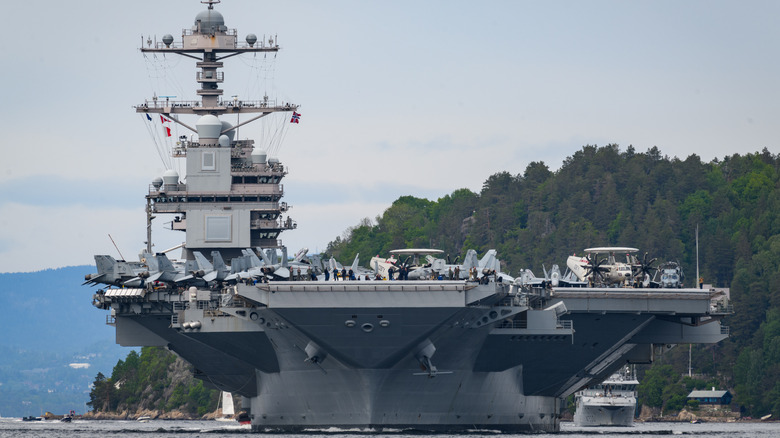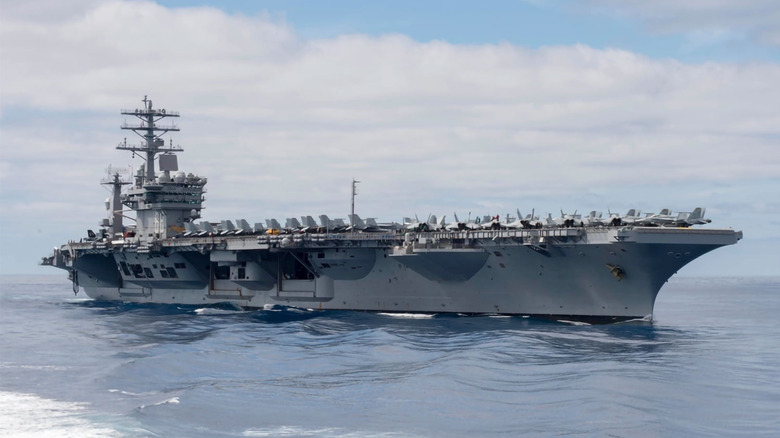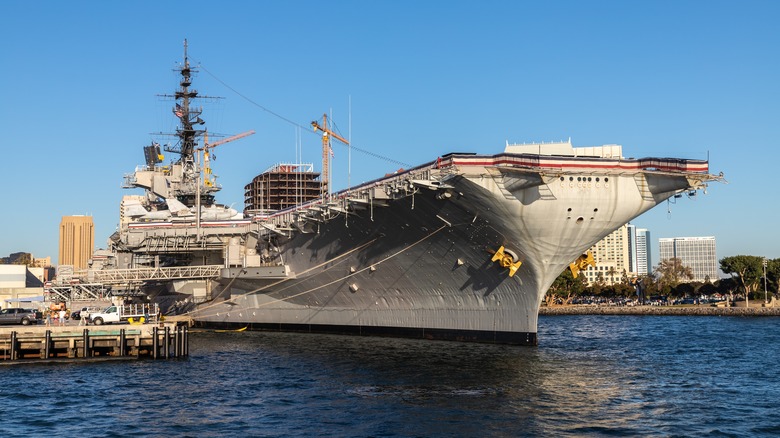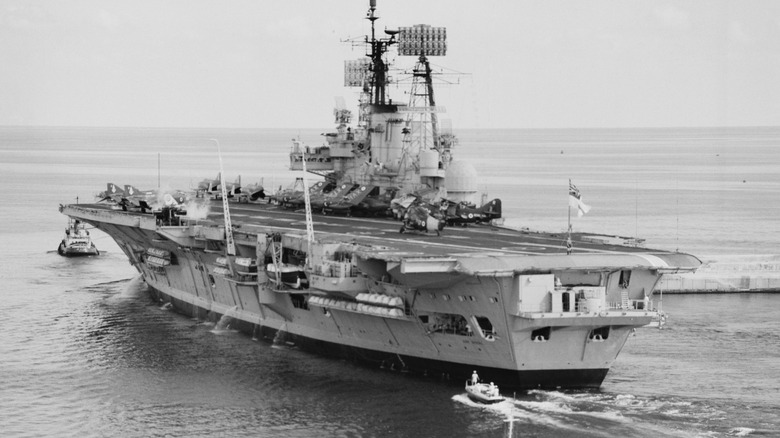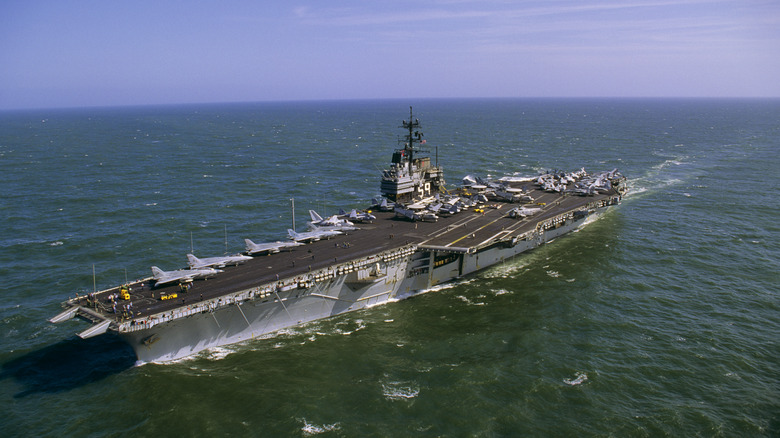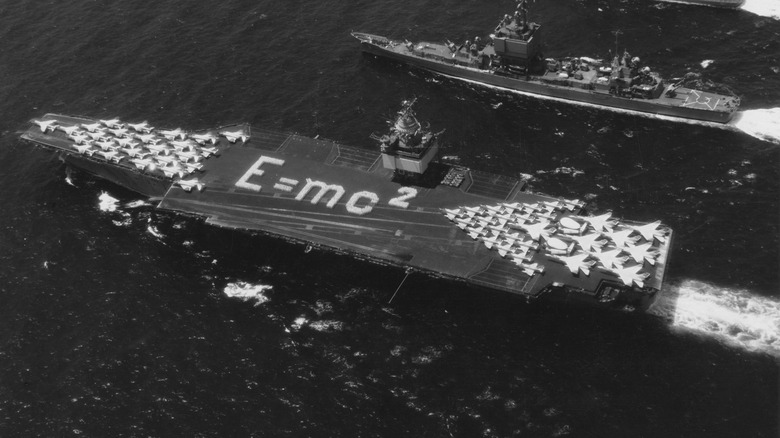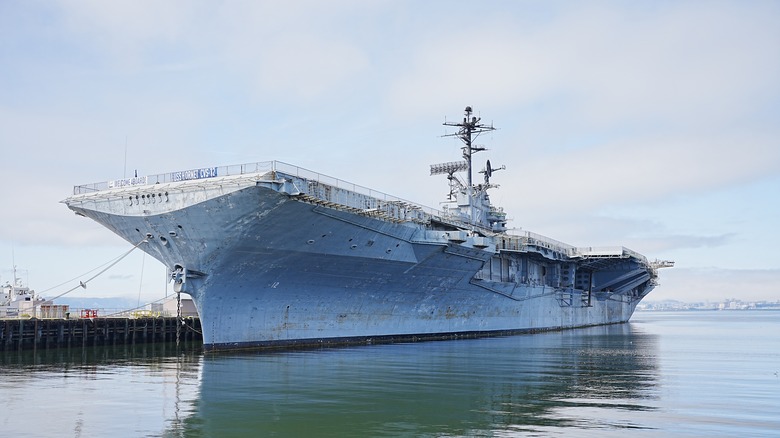6 Innovative Aircraft Carriers That Led To The USS Gerald R. Ford
The USS Gerald R. Ford, named after the 38th President of the United States, is the next generation of American nuclear aircraft carriers. It gives a whole new meaning behind the name "supercarrier." While the nickname typically refers to larger-than-average aircraft carriers, which this carrier is, the Gerald R. Ford also deserves it in the sense that it contains a slew of new innovations not seen in its predecessors. When it comes to size, the new ship (launched in 2017) is 1,092 feet long (332.9 meters), with a flight deck that is 256 feet (78 meters) wide. Furthermore, it can hold more than 75 aircraft and house a crew of over 4,500.
There are two Ford-class carriers already serving in the US Navy: The first of its class and namesake, Gerald R. Ford, and the USS John F. Kennedy (CVN-79). The USS Enterprise (CVN-80) is expected to launch in 2028, and 2032 should see the launch of the USS Doris Miller (CVN-81). One of its technological achievements is requiring a smaller crew (roughly 1,000 fewer) than the Nimitz-class carrier, accomplished by an increase in automated systems. These accomplishments wouldn't exist without the technology and ideas that came before it. A long line of technological advancements, breakthroughs, and new designs helped the carrier become the ship that it is today. The USS Gerald R. Ford has the following aircraft carriers to thank for the powerhouse that it is.
USS Nimitz (CVN-68)
The USS Nimitz is the oldest aircraft carrier still in service today, serving in the US Navy since 1975 and still going strong. That's a 49-year term of service, which is exceptionally long for any vessel. Nuclear-powered carriers, however, are designed to serve a 50-year stretch, and while the Nimitz should retire in 2025, several overhauls have slightly extended its term of service. The Navy will keep the carrier in service until sometime in 2026. For nearly 50 years, the Nimitz has been the gold standard for American aircraft carriers.
While the Gerald R. Ford improves upon much of what made the Nimitz successful, like the introduction of steam-powered catapults, the 10 Nimitz-class carriers in operation still function well. The design for the Nimitz-class gradually changed as the first few (CVN-68 through CVN-71) had a fully loaded displacement of 97,000 tons, while CVN-72 through CVN-76 have a displacement of 102,000 tons.
The Nimitz carriers typically housed a little over 5,000 ship company and airmen, whereas the newer carrier class can accomplish its mission with 4,660 crewmembers. The USS Nimitz itself is known for a number of "firsts." When it participated in Operation Iraqi Freedom in 2003, it was the first carrier to deploy the new F/A-18 Super Hornet and the E-2C Hawkeye 2000. The USS Nimitz was also the first carrier on which an F-35C Lightning II performed an arrested landing.
USS Midway (CVB-41)
The 1942 Battle of Midway was a significant victory for the United States because it completely turned around the war in the Pacific. This momentous victory required a commemoration of equal significance. Thus, the USS Midway (CVB-41) was built. In honor of the battle, the USS Midway was commissioned in 1945 as the largest ship in the world. Fully loaded, she had a displacement of 69,000 tons, could carry 120 aircraft, and housed roughly 4,000 crew. CVB-41 had a great deal of firsts for the US Navy.
It was the first ship to feature an armored flight deck, the first American carrier to venture into sub-Arctic conditions in the middle of winter, the first American ship to fire a ballistic missile from the sea, and the first carrier to have jets make fully automatic landings with new technological advancements at the time. It was also the first American carrier to have its homeport be in a foreign country (Japan).
As fighter jets became more prominent, carriers needed more space to accommodate them than straight runways could provide. She was decommissioned for four years in 1966 to receive an overhaul that included fitting a new angled flight deck on her. Midway returned to service in 1971 to participate in the last years of the Vietnam War. She participated in Operation Desert Storm in 1990 and then a rescue mission in the Philippines in '91. In 1992, the carrier returned to San Diego, California, where she was decommissioned and now rests as a museum.
HMS Ark Royal (R09)
Yes, it's a British ship, but it's a heavily influential aircraft carrier that has shaped the future of carrier design forever. The HMS Ark Royal was the first carrier to be built and launched with an angled flight deck in February 1955. Witnessing the superiority of an angled flight deck, every nation now constructs its carriers with such a design. Before this seemingly simple design, carriers were built with a single straight runway, but coordinating takeoffs and landings was a logistical nightmare.
An angled runway allows jets to take off on one part of the flight deck while others land on another. Additionally, there's plenty of room on the flight deck for aircraft to sit when they're not in use. While America had been testing the new runway on a number of its carriers because the British were kind enough to share, the tests had only been painted lines on the deck or extensions added to a carrier long after the ship had been constructed.
The first American carrier built and launched with an angled runway was the USS Forrestal, which launched in October of the same year as the HMS Ark Royal. However, the Forrestal would influence the USS Gerald R. Ford in more ways than just its flight deck.
USS Forrestal (CVA-59)
When the USS Forrestal was still under construction in 1951, its flight deck was originally intended to be a flushed armored deck like previous carriers. That changed with the discovery of the British design for an angled deck. Historian Norman Friedman praised the angled deck, saying, "The greatest change was the shift from that flush deck to the modern angled deck, which at a stroke solved most of the problems of the design." Not only did the new angled flight deck allow the USS Forrestal to launch and recover aircraft simultaneously, it allowed pilots to immediately take off and reattempt a landing if they missed the arresting cables necessary for landing on a carrier.
The Forrestal-class carriers earned the nomenclature "supercarrier" because it was significantly larger than anything before it. Granted, it was only 64 feet longer than its predecessor, the Midway-class carrier (1,036 feet vs 972 feet, respectively); it weighed 59,650 tons, while the class before it weighed no more than 45,000 tons.
The USS Forrestal came about in 1955, long after World War II when slower propellor attack planes were phased out, and a new generation of fighter jets took their place. Fighter jets were bigger, meaning they needed larger storage space as well as a longer runway to take off and land on. While the USS Gerald R. Ford is the largest aircraft carrier on the open seas now, the USS Forrestal held that title from 1955 to 1961, when the first nuclear-powered carrier took to the seas.
USS Enterprise (CVN-65)
The Gerald R. Ford might be considered the largest aircraft carrier, but the USS Enterprise (CVN-65) holds the record for being the longest carrier the US Navy has commissioned, with a length of 1,123 feet. Thanks to its length, it could carry 85 fixed-wing aircraft. That's not the legacy the Enterprise left for the USS Gerald R. Ford, however.
The biggest accomplishment that the Enterprise made was being the first nuclear-powered aircraft carrier, not just in America, but the world. Don't confuse the USS Enterprise (CVN-65) with the upcoming Ford-class iteration of the carrier that has the hull designation CVN-80. The new Enterprise isn't expected to launch until sometime in 2025.
Enterprise (CVN-65) was commissioned in 1961 and decommissioned in 2017. Being the first nuclear carrier, it wasn't as efficient as modern-day carriers. Unlike the Ford-class carriers, the Enterprise had eight nuclear reactors onboard, using two to power each of its four propellers. These many reactors helped the carrier reach speeds of over 30 knots while producing 280,000 shaft horsepower.
USS Hornet (CV-12)
There have been more than a few ships with the Hornet name on their hull. After the USS Hornet (CV-8), the seventh ship in the US Navy to bear this name, sank in World War II, another carrier was given the same name in 1943. This Hornet had the hull designation CV-12. While there wasn't much about the Essex-class carrier that anyone would say stood out in the long line of carriers before it (though Essex-class did come with its own innovations), it was one of the few American carriers to be fitted with the newly designed angled flight deck as a test before the Navy-commissioned the USS Forrestal.
The USS Hornet (CV-12) served a rather exciting tour of duty during her time with the Navy. The ship started out as a traditional carrier, sailing throughout the Pacific Ocean during the latter end of World War II until 1947 when it was decommissioned. However, it was recommissioned in 1951 and received significant weapons and systems upgrades. Because of these upgrades, the USS Hornet was converted into an attack aircraft carrier, which came with a new hull designation, CVA-12. That wouldn't be her only conversion, though.
After a lengthy service in the Navy's 7th Fleet, the USS Hornet underwent another conversion in 1958, this time becoming an Antisubmarine Warfare Support Carrier with the new designation CVS-12. The Hornet would go on to serve until 1970, when it was decommissioned for the last time, and the name was retired. The USS Hornet now rests in Alameda, California, as a museum.
